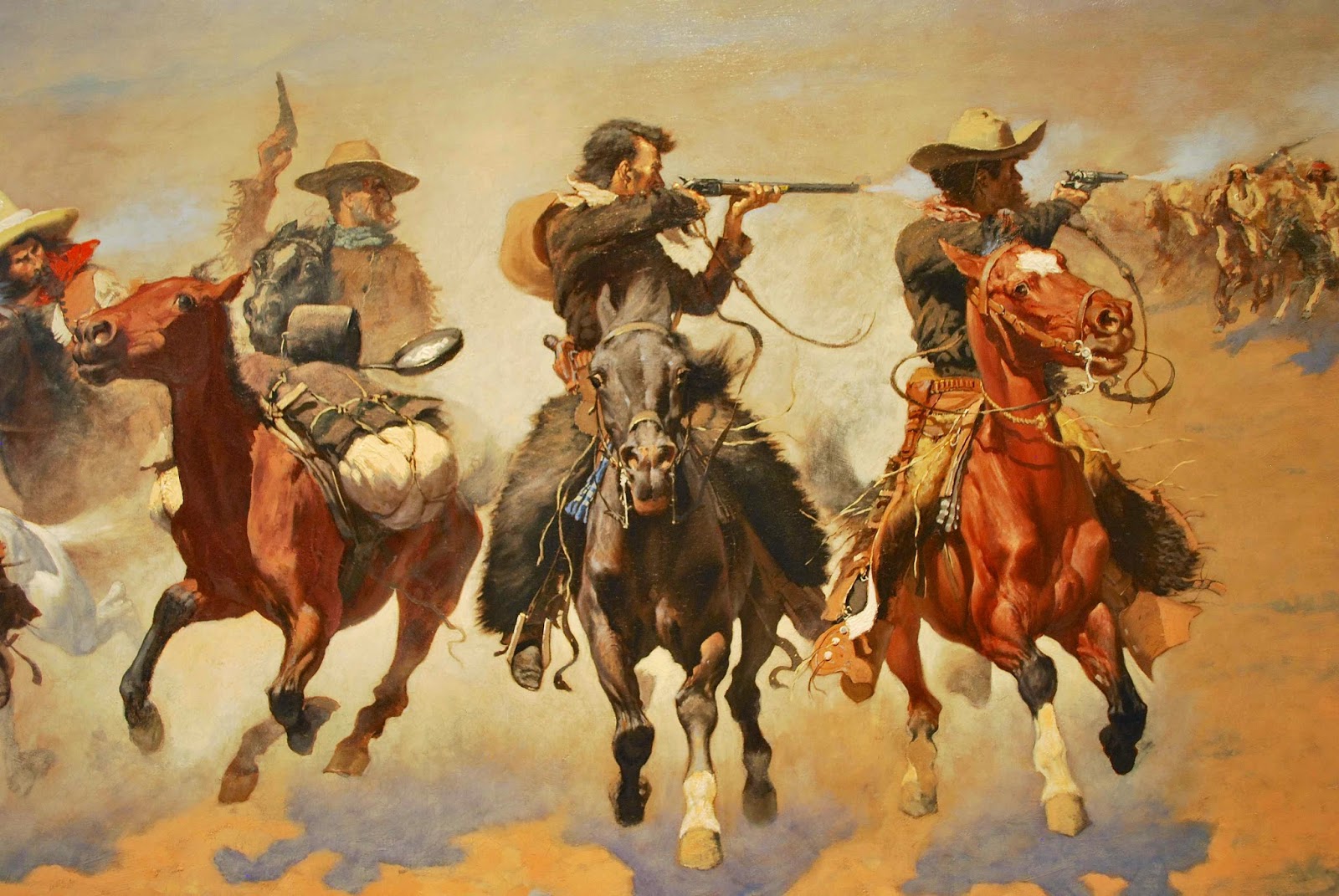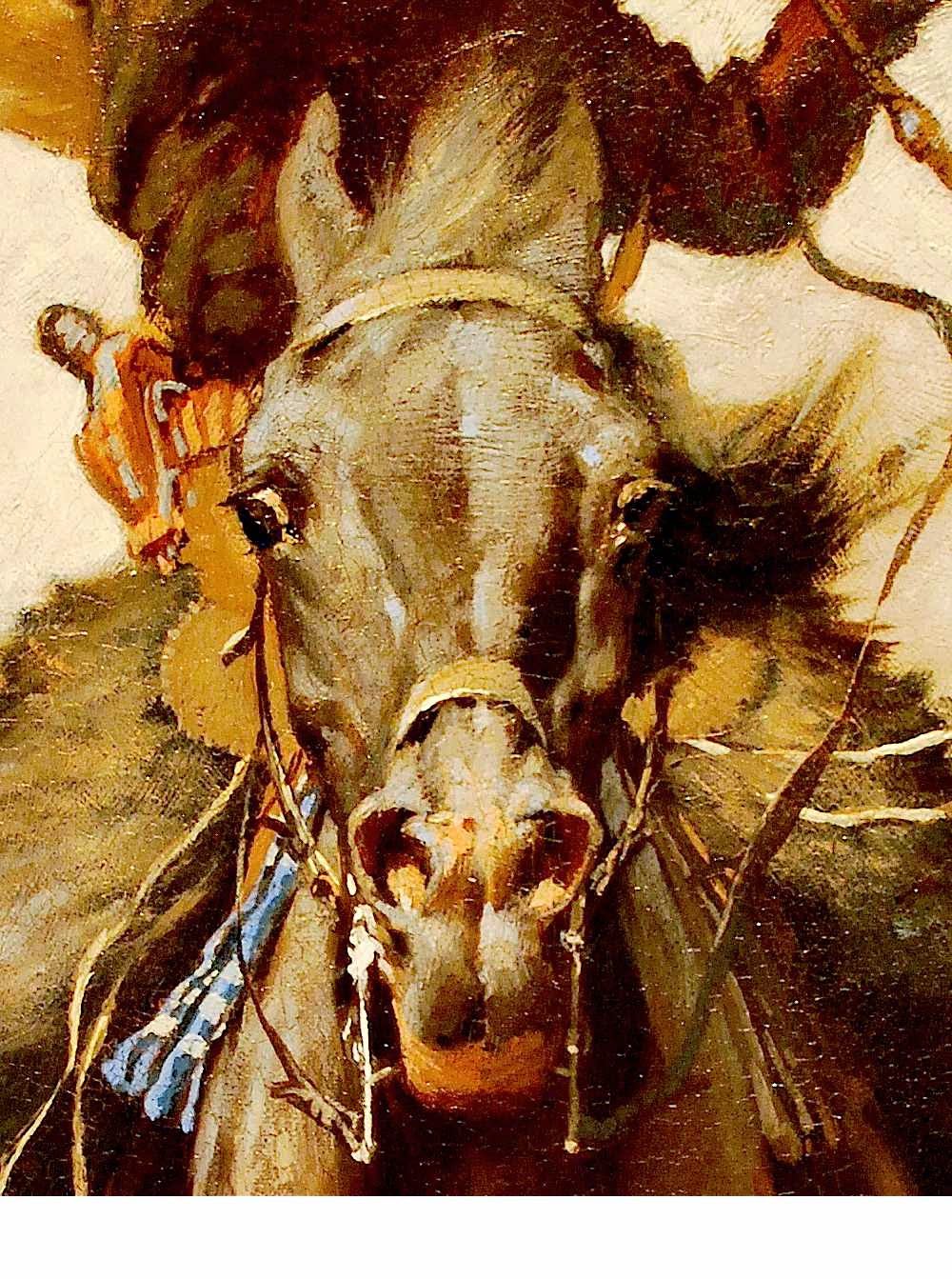 |
"A Dash for the Timber" (1889) by artist Frederic Remington
|
ART
Examining
Remington's
Remington's
"A Dash for
the Timber"
Oil on Canvas (c. 1889)the Timber"
The Amon Carter Museum
of American Art
in Ft. Worth, Texas
---------------------
---------------------of American Art
in Ft. Worth, Texas
---------------------
From time to time ARTSnFOOD selects a work of art to examine, very closely. This week we take a look at "A Dash for the Timber" (1889) by the artist Frederic Remington. As we look, notice the brush strokes, notice the under painting of color behind the surface and notice so many of the details which are easily missed. With a typical long viewing, usually 20 to 40 seconds* in front of a painting in a museum, we see so little, but upon a closer look all of the details become fascinating. *Most works of art in museums hold the viewers attention for only 3 or 4 seconds, before the museum guest moves on to look at the next artwork.
Between 1885 and 1888, Frederic Remington made a number of trips to the Southwest, often to cover the activities of the U.S. Cavalry and their conflicts with the Apache Indians. He was deeply influenced by the stark landscape of the region and filled his sketchbooks with color notes and observations about the special quality of the light. In 1889, he wrote to a friend that he was working on "a big cowboy picture," and he needed two or three pairs of different chaps for reference. He was referring to this painting, which launched his career when it received favorable critical attention at the National Academy of Design in New York the following year. The overall effect of the this composition is riveting, as the fleeing riders gallop forward directly toward the viewer. Interestingly the painting has a cinematic quality which anticipates the many "Western" movies that were to happen a generation or two later! Frederic Remington lived from 1861 until 1909.
 |
| Detail of a cowboy's profile from "A Dash for the Timber" by artist Frederic Remington |
 |
| The Amon Carter Museum of American Art considers Frederic Remington's "A Dash for the Timber" one of the most important works of art in their permanent collection. |
 |
| The Amon Carter Museum of American Art in Ft. Worth, Texas. |
A Close Look at
Frederic Remington's
Masterpiece:
"A Dash for the Timber"
Painted in 1889
 |
Remington had seen the photographic work of Eadweard Muybridge and
knew how to realistically paint a galloping horse. |
In 1872, Muybridge set up a series of 24 cameras and was able to take multiple shots of the running habits of various racehorses, in a kind of film-strip style. The photographs demonstrated that all four legs often left the ground, although not as artists had depicted them, with the legs stretched out fore and aft, but rather with the four legs tucked up under the horse.
 |
| Eadweard Muybridge's sequential photos "The horse in motion". |
 |
| Detail photo of the Indians in pursuit. The information is all there but executed with only a few brush strokes for each horse and rider. |
 |
| Detail photo of the gun, whip and part of the bridle. |
 |
| Horses are not easy to draw or paint, but Remington makes them very convincing and realistic. |
 |
| Capturing the moment of death. The Cowboy pictured has been shot through the heart, you can see the blood on the front of his shirt. |
 |
| "The Falling Soldier" is a photograph taken by photojournalist Robert Capa at the moment of death. Spanish Civil War, c. 1936. |
 |
| Almost lost in the composition is an eighth cowboy, fourth from the left, in the background. |
 |
| The lost cowboy's horse's head peeks out from below the white horse as seen above. |
 |
| An overview of the lost cowboy and his horse. |
 |
| One cowboy is possibly Mexican, he is wearing a large sombrero. |
 |
| Detail photo of the skillet with eggs still in the pan. |
 |
| Notice the buffalo hide chaps on this cowboy. |
 |
| The title is "A Dash to the Timber". These are the timber(s), a place to gain cover. It is interesting to see Remington's painting technique, with his quick scumbling-in of the sky and foliage. |
Below is a detail of the brush technique Remington used in the painting.
Above is a large final look at Remington's "A Dash for the Timber" (Oil on Canvas, 1889, at The Amon Carter Museum of American Art).
Stop by and see this Remington masterpiece the next time you are in Ft. Worth Texas.
Stop by and see this Remington masterpiece the next time you are in Ft. Worth Texas.
(Source: All photos were taken by ARTSnFOOD staff, with permission of the Amon Carter Museum staff. Introductory text came from information provided by the museum.)
FOOD
"7-UP" BISCUITS
Fast, easy to make and so good! Recipe is hard to find.
INGREDIENTS:
4 cups Bisquick brand baking mix
1 cup sour cream
1 cup 7-Up
1/2 cup melted butter
DIRECTIONS:
• Mix Bisquick, sour cream and 7-Up. Dough will be very soft.
• Knead and fold dough until dough incorporates all of your Bisquick mix.
• Pat dough out and cut biscuits using a round biscuit or cookie cutter.
• Pour melted butter into the bottom of a baking sheet pan or 9x13 casserole dish.
• Place biscuits on top of the melted butter.
• Bake for 12-15 minutes at 425 degrees or until brown.
(Source: Recipe is from a friend & included in the Atkinson Family Cookbook)
Until later,
Jack
ARTSnFOOD, is an online publication dedicated to "The Pursuit of Happiness through the Arts and Food." ™ All rights reserved for all content. Concept, Original Art, Original Text & "Original or Assigned Photography" are © Copyright 2014 Jack A. Atkinson under all International intellectual property and copyright laws. All photographs were taken and/or used with permission. Artworks © individual artists, fabricators, respective owners or assignees.























































